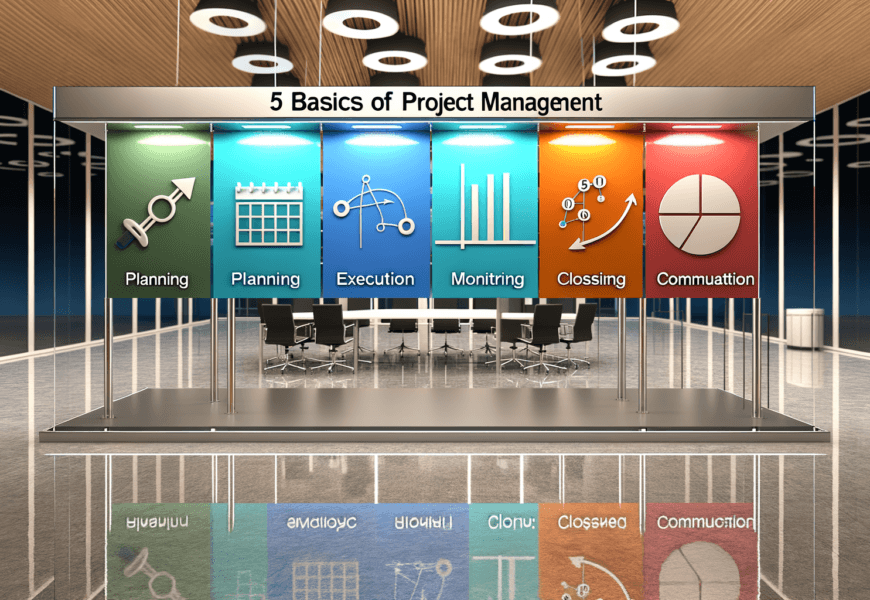In today's fast-paced business environment, effective project management is more crucial than ever. Whether you're steering corporate initiatives or launching entrepreneurial ventures, mastering the art of project management can make or break your success. In this guide, we'll delve into key strategies, explore advanced tools, and uncover best practices to elevate your project management game. Let's embark on this journey to project excellence where your organizational goals become tangible achievements.
Understanding Project Management Fundamentals
Project management is more than just a buzzword—it's the systematic process of planning, executing, and overseeing projects to achieve specific goals within specified constraints like time, scope, and budget. Its importance cannot be overstated, as it ensures that strategic objectives are met efficiently and effectively.
Definition and Importance of Project Management
At its core, project management involves applying knowledge, skills, tools, and techniques to project activities to meet project requirements. It is crucial in aligning project objectives with the strategic goals of an organization, improving productivity, and ensuring the optimal use of resources. A well-managed project not only delivers the expected results but also enhances the team's overall satisfaction and morale.
Core Principles and Phases of Project Management
Project management is typically broken down into five phases: initiation, planning, execution, monitoring, and closing. These phases collectively make up the project lifecycle and provide a structured approach to manage projects from start to finish.
- Initiation involves defining the project at a broad level.
- Planning requires detailed formulation of a schedule, cost estimates, and resource allocation.
- Execution is where the actual work is done to create project deliverables.
- Monitoring ensures that project activities are on track and within scope.
- Closing finalizes all project activities, culminating in the successful delivery and documentation of all aspects of the project.
Key Roles and Responsibilities in a Project Team
A project team is typically composed of various roles, each contributing unique skills and knowledge. Key roles include:
- Project Manager: Leads the project team, plans and allocates resources, and ensures project goals are met.
- Team Members: Execute tasks as per their skill sets and contribute to project goals.
- Stakeholders: Individuals or groups with a vested interest in the project outcome.
- Project Sponsor: Provides funding and support for the project, advocating for the project across the organization.
Essential Project Management Methodologies
Understanding various project management methodologies is vital for selecting the right approach for your projects. Let's explore some popular methodologies.
Overview of Methodologies like Agile, Waterfall, Scrum, and Kanban
- Agile is an iterative approach emphasizing flexibility and customer feedback, particularly effective for projects in dynamic environments.
- Waterfall is a linear, sequential approach, best suited for projects with clear goals and stable requirements.
- Scrum, a subset of Agile, focuses on delivering incremental value through collaborative teamwork in short cycles called sprints.
- Kanban is a visual system for managing work as it moves through a process, aiming to optimize workflow and efficiency.
When and How to Apply These Methodologies
Choosing the right methodology depends on factors like project complexity, stakeholder requirements, and project constraints. Agile and Scrum are ideal for projects needing adaptability, while Waterfall is best for tightly controlled or regulatory environments. Kanban is suitable for continuous delivery processes requiring high flexibility.
Pros and Cons of Each Approach
Each methodology has its strengths and drawbacks:
- Agile: Excellent for evolving projects but requires constant stakeholder engagement.
- Waterfall: Suitable for structured projects but lacks flexibility for changes.
- Scrum: Enhances team collaboration but can be resource-intensive.
- Kanban: Great for visibility, though it may lack structure in fast-paced projects.
Tools and Software for Project Management
Choosing the right tools and software can significantly impact your project's workflow and success.
Must-Have Project Management Tools and Their Features
Top project management tools include Asana, Trello, Jira, and Microsoft Project. Each offers distinctive features such as task tracking, collaboration spaces, and resource management.
Choosing the Right Software for Your Team
Selecting the right software requires assessing your team's needs, budget, and project complexity. For instance, Jira is favored for software development projects, while Asana is popular for its user-friendly interface and broad applicability.
Integrating Tools for Seamless Workflow
Integrating these tools with other software like Slack or Google Workspace can streamline communication and improve workflow efficiency. Effective integration allows for real-time updates and seamless transitions between tasks.
Best Practices for Effective Project Management
Beyond methodologies and tools, adhering to best practices ensures successful project delivery.
Communication and Collaboration Techniques
Effective communication is the cornerstone of successful project management. Regular meetings, email updates, and collaborative platforms like Slack or Microsoft Teams can enhance team communication and collaboration.
Risk Management Strategies
Proactively identifying, assessing, and managing risks is crucial. Employing risk analysis tools and maintaining a risk register can help anticipate potential challenges, enabling timely interventions.
Time Management and Prioritization
Prioritizing tasks using techniques like the Eisenhower Matrix or setting clear deadlines ensures efficient time management. Leveraging tools like calendars and timers also helps keep project timelines on track.
Enhancing Team Performance
A high-performing team is instrumental in a project's success.
Building and Leading a High-Performing Team
Leadership plays a pivotal role in team dynamics. Encourage open communication, provide constructive feedback, and foster an inclusive culture to build a resilient and motivated team.
Encouraging Productivity and Motivation
Implement motivation techniques like recognition programs and goal-setting frameworks to boost team morale and productivity. Create a balanced workload to prevent burnout and maintain enthusiasm.
Resolving Conflicts and Fostering a Positive Work Environment
Conflicts are inevitable but manageable with the right strategies. Encourage dialogue, active listening, and empathy to address disputes. Cultivating a positive work environment through team-building activities can improve team cohesion.
Measuring and Analyzing Project Success
Evaluating project success is crucial for continuous improvement.
Setting KPIs and Success Metrics
Define clear KPIs (Key Performance Indicators) and success metrics aligned with project goals. These could include timeline adherence, budget compliance, quality standards, and customer satisfaction.
Tools for Tracking Project Performance
Tools like Gantt charts and dashboards in project management software provide real-time insights into project progress and performance against set KPIs.
Analyzing Outcomes to Improve Future Projects
Conduct post-project reviews to analyze outcomes and extract valuable lessons. Implement a project feedback loop to identify areas for improvement, ensuring success in future initiatives.
Project management is the backbone of successful initiatives in any industry. By understanding its fundamentals, employing the right methodologies, leveraging powerful tools, and embracing best practices, you can lead your projects to successful outcomes. Start implementing these strategies today and watch your team’s performance and project success reach new heights. Ready to take your project management skills to the next level? Dive deeper into our resources and master the art of project excellence.



